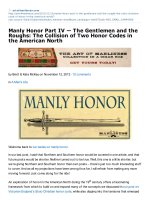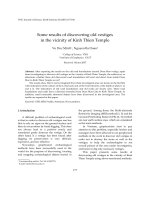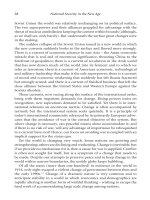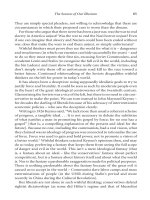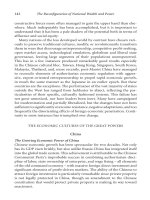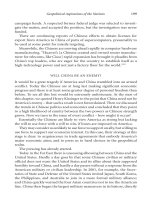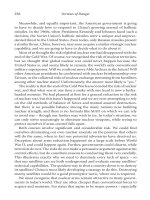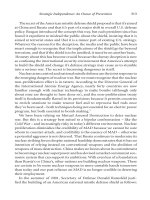Masters of craft old jobs in the new urban economy
Bạn đang xem bản rút gọn của tài liệu. Xem và tải ngay bản đầy đủ của tài liệu tại đây (18.29 MB, 369 trang )
M asters o f
Craf t
Masters of
Craft
Old Jobs in the New Urban Economy
RichaRd E. OcEjO
Princeton University Press
Princeton & Oxford
Copyright © 2017 by Princeton University Press
Published by Princeton University Press, 41 William Street,
Princeton, New Jersey 08540
In the United Kingdom: Princeton University Press, 6 Oxford Street,
Woodstock, Oxfordshire OX20 1TR
press.princeton.edu
Jacket art courtesy of Shutterstock
All Rights Reserved
ISBN 978-0-691-16549-3
British Library Cataloging-in-Publication Data is available
This book has been composed in Whitman, Burford and Helvetica Neue
Printed on acid-free paper. ∞
Printed in the United States of America
1 3 5 7 9 10 8 6 4 2
For Chantal, my heart, and for Rita, the answer to every question
cOntEnts
Acknowledgments
Preface. The Daily Grind
Introduction. A Stroll through the Market
Pa R t i
1 The Cocktail Renaissance
2 Distilling Authenticity
3 Working on Men
4 Show the Animal
ix
xi
1
23
25
50
76
101
Pa R t i i
127
5 How Middle-Class Kids Want Working-Class Jobs
6 The Science and the Art
7 Service Teaching
8 Getting the Job
129
159
190
225
Epilogue. Outcomes, Implications, and Concluding Thoughts
Methodological Appendix
Notes
References
Index
250
267
285
323
339
acknOwlEdgmEnts
Before I begin I have a few people I would like to thank. First, I reserve the
biggest thanks for the people in these jobs, workplaces, and industries who
opened up their lives to me. This book would not exist without your generosity. I’ll never forget the six years I spent in your company, and I remain fascinated by your work.
Although initially skeptical when all I talked about was the importance of
ice in cocktails instead of finishing my dissertation, Sharon Zukin encouraged me to start a side project on cocktail bars. I truly appreciated her early
support and guidance. Similarly, Eric Schwartz showed tremendous support
for this project as it expanded and evolved (while probably wishing I was focusing more on my first book). I thank him for always believing in me and
getting this book under way. When Eric left Princeton University Press to
work at Columbia, I was pretty sure I was going to stay at Princeton for this
book, because I enjoyed the overall experience so much the first time around.
Still, I wanted to meet Eric’s replacement before I made a final decision. I’m
so lucky Princeton hired Meagan Levinson, who has been the perfect person
to work with through the bulk of the writing. Her editorial skills are remarkable, and I’ve benefited tremendously from her ability to see both the forest
and the trees, and to know how they relate to each other. I would also like to
thank Sara Lerner and Samantha Nader at Princeton for guiding this book
through production, and Jennifer Harris for her helpful copyediting corrections and suggestions.
I’m blessed to have colleagues who are also good friends. Always first are
my CUNY boys, who have offered wonderful comments on this project and
joined me in many a cocktail over the years, especially Alex Frenette, Jon
Wynn, and Jeff London. I’ve always written in solitude, but for some reason
I joined a writing group a few years ago, when I first started thinking about
what the book would actually look like. (And somehow that group turned
into an editorial board for a journal.) For their insightful thoughts at a key
Acknowledgments
step in the process I would like to thank Greg Smithsimon, John Krinsky, and
Debbie Becher. I had the pleasure of attending two of the Experiencing the
Creative Economy conferences at the University of Toronto’s Martin Prosperity Institute at important junctures in this project. From these experiences I
want to especially thank Kevin Stolarick, Brian Hracs, Doreen Jakob, Pacey
Foster, Oli Mould, and Atle Hauge. I must also thank the following folks for
their feedback, encouragement, and friendship during this journey: Michaela
DeSoucey, Andrew Deener, Black Hawk Hancock, Damian Williams, Tim
Dowd, Yasemin Besen-Cassino, Japonica Brown-Saracino, Richard Lloyd, Randol Contreras, Wendy Guastaferro, Jen Johnson, and Shyon Baumann. Finally,
thank you to the three reviewers who gave so much of their time to offer so
many wonderful thoughts on how to improve this book (and sorry the first
draft was so long).
Thanks to the work-study students who helped me transcribe some of the
audio recordings over the years. Other than their services, my small annual
amount of departmental travel funding, and a highly appreciated award from
John Jay’s Office for the Advancement of Research to pay for the index, I received no other formal support (financial or otherwise) for this project and
book.
No one’s story of how they met their romantic partner is better than the
one of how I met my amazing wife, Chantal. We met at 4 a.m. on Bourbon
Street in New Orleans, outside the Old Absinthe House, while I was conducting research at Tales of the Cocktail, and she was covering it for the Village
Voice. A smoke-filled conversation on a humid night, while surrounded by
cocktail people, turned into a few dates back in New York, which became the
relationship that defines my world. Chantal, you saw almost every step of this
project, the highs and lows, and always had an open ear, a piece of advice (always from the heart), and a warm embrace for me. Shortly after I finished my
fieldwork our daughter, Rita, was born. Rita, I’m thrilled I’ve gotten to see so
much of you as you have grown from a baby to a toddler to a little girl (in part
because of your love of steak). I’m already so proud of you, and I can’t wait to
see what else you have in store. I love you both.
‹x›
P R E fa c E
t h E d a i ly g R i n d
Thus a man’s work is one of the things by which he is judged, and certainly
one of the more significant things by which he judges himself.
—Everett Cherrington Hughes1
The subway is never too crowded when Joaquin goes to and from work.2 A
bartender by trade, Joaquin, 29, works at Death & Co., one of the most popular cocktail bars in New York City. His shift runs from 6 p.m. to 2 a.m. on
Tuesdays, Thursdays, Fridays, and Sundays, but he arrives a couple of hours
before the bar opens, and leaves an hour or so after last call (sometimes stopping at another cocktail bar nearby for a nightcap or two before heading home).
So he commutes to work in the late afternoon and returns home around 3 a.m.,
waiting bleary-eyed on a near-empty platform for the F train back to Brooklyn.
But the hours are worth it to make and serve cocktails for a living. “I walk into
work feeling good, I walk out of work feeling way better. Tired as hell, but it’s a
satisfying tired. I sleep well.”
Born in Ecuador, raised in Miami, and educated at Boston University, Joaquin moved to New York City in 2005, at the age of 27. Uncertain of his career path, he started bartending to pay the bills, as he did after college. After
early stints at beer and shot joints, he moved on to places where the quality of
the drinks only sometimes mattered, until he got his job at Death & Co. This
Friday Joaquin wakes up around noon, gets out of bed, and spends a couple of
hours trolling various food and drink websites and blogs to stay abreast of the
latest trends. Today he is most interested in learning about new ingredients
that chefs are using, for inspiration. Last month, Joaquin worked at a dinner
for a supper club and paired five cocktails with five courses.
The next month’s dinner sold out quickly. “So now I know the pressure’s on,
and I gotta do it better,” he says.
Joaquin understands his role behind the bar to be like a performance on
a stage. He waits to shower and shave until just before he leaves for work,
Pr e fAc e
to look as fresh and awake as possible. Light-skinned with light brown hair,
he maintains a fashionable amount of stubble. Wearing blue-gray pants with
cuffs rolled just above the ankle, boat shoes, and a white V-neck t-shirt, Joaquin walks from the sunny downtown streets of the East Village into the
windowless bar. He goes downstairs to change into his work clothes: a buttondown dress shirt, tie, vest, arm garters, slacks, and dress shoes. In uniform,
he checks himself in the mirror to make sure everything is on just right. He
ties on an apron and starts prepping the backbar by filling bins with five different varieties of ice, juicing lemons and limes by hand, and making sure
the dozen or so bitters bottles the bar uses are full. By 6, he is ready for his
audience.
The tiny town of Gardiner, in Ulster County, is a two-hour drive north of New
York City. Along with the natural beauty of the mid–Hudson Valley region,
one of the town’s attractions is Tuthilltown Spirits, on the site of a historic
landmark gristmill, which turned grain into flour for over two hundred years
with waterpower from the Shawangunk Kill. The distillery is down a short,
dead-end dirt path off Tuthilltown Road called Grist Mill Lane. Ralph, the
company’s co-owner, purchased the property in 2001, and with his partner,
Brian, renovated the two granaries into a craft distillery operation and a rickhouse, or a warehouse for storing whiskey barrels as their contents slowly
age. In addition to the converted granaries, Ralph’s house, some storage facilities, and a port-a-potty, the property consists of a large field with patches
of overgrown grass. The people at Tuthilltown are considering growing crops
(heirloom varieties of apple, corn, and rye) for making spirits. For now, some
of its employees use the field for recreational camping over the summer.
Their rent is to mow the grass.
Liam wakes up in his teepee at the break of dawn. He puts on a pair of
thick khaki-colored work pants and worn brown boots. With the temperature
already approaching ninety degrees, and a long day ahead of making whiskey
amid the steaming hot stills, he does not bother to put on a shirt. Twentyseven years old and over six feet tall with a thick mustache, a stubbly beard,
shaggy brown hair, and an upper body chiseled by more than a year of lifting
heavy barrels and equipment, Liam resembles a rugged character from American folklore. Born and raised in nearby Rhinebeck, he bartended locally for a
few years after he graduated from SUNY New Paltz, a town close to Gardiner,
with a degree in geology. Wanting a change, but wanting to still work with
‹ xii ›
t h e dA i ly gr i n d
his hands, he responded to an ad on Craigslist for a job at a small distillery
that makes handcrafted spirits from local ingredients. Although he had never
distilled before, the job appealed to several of his interests and sensibilities—
manual labor, spirits, and sustainability—and the chief distiller, Joel, happened to be an old customer from his bartending days.
Liam and I walk behind the distillery to finish priming six-gallon barrels for today’s barreling, and prepare more for tomorrow. Two sets of six sit
stacked in pyramids from yesterday, each one full with water. We remove the
wooden bungs from the holes with a hammer, drain the barrels into a cistern,
and then place them upright on a wooden pallet to be forklifted into the distillery. We take twelve more, stack them and fill them with water from the
hose, and hammer the bungs in with a rubber mallet. Letting barrels sit for
a day or so with water primes them by causing the wood to expand, thereby
closing any possible leaks. “You would rather lose water than whiskey,” says
Liam. By 10 a.m., we are ready to start barreling.
Miles usually takes a car service to his job as a barber from his apartment in
Park Slope, Brooklyn. Half African American and half Puerto Rican, Miles
grew up in various apartments (some in public housing projects) throughout
all five boroughs, but mainly in the Bronx. As usual, Miles arrives ten minutes or so before 11 a.m., when Freemans Sporting Club opens. Seven young
men waiting for haircuts stand outside the gated front door, which opens
to a high-end men’s clothing store. Past shelves, tables, and rails of handmade shirts, pants, suits, vests, jackets, shoes, and ties (and some samples of
taxidermy) is the entrance to the barbershop. Miles, who started cutting his
friends’ hair at age 15, was drawn to the barbershop/clothing combo. “I was
always into fashion, menswear. If anything, I’m just kind of like a creative
dude. I’m into art. I just like creative things.”
Barbers stand on their feet with their arms half-elevated and have to be
“on” for clients and attend to their needs for nine hours a day. Some can start
“banging out” haircuts immediately, but others prefer easing into the day
gradually, at their own pace. After entering the shop through the building’s
side door in Freemans Alley, Miles takes his tools out of his locker and lays
them out on a towel at his station. He checks his spray bottle’s water level
and chats for a few minutes with the other barbers as they also set up. More
men have arrived as the shop opens. Freemans is a walk-in shop without appointments, which leads clients to come early. Clients can request a specific
‹ xiii ›
Pr e fAc e
barber, which may mean a longer wait, or just see the next available one. As
one of the shop’s more popular barbers, and someone his colleagues recognize
as an expert on fades (from having worked in “ ’hood” shops in black neighborhoods), Miles already has three customers who put their names in with
the receptionist to have him cut their hair. He greets a regular client with a
handshake into a half-hug, and tells him to sit in his chair and he will be right
back. Miles then goes to the restaurant next door that operates an espresso
bar during the day and orders an iced Americano. He flips through a men’s
fashion magazine he picked up in the window of the clothing shop, takes a
few sips, and sits on the bench outside. At 11:15 he goes in and cuts his client’s
hair. At 12:30 he finishes a second one, and then goes back outside to check
his phone and chat with Mark, another barber, who is having a cigarette,
while two other clients on his list continue to wait. Meanwhile, Van, whose
station is next to his, has started on his fourth haircut of the day. The clients
do not complain. They simply sit quietly and take in the atmosphere. As the
day goes on Miles settles into his rhythm and starts banging out cuts every
half hour.
Five days a week, from Sunday through Thursday, Giancarlo leaves his Harlem apartment, which he shares with three strangers, and rides the A train
down to 14th Street, to his job as a butcher at Dickson’s Farmstand Meats in
Chelsea Market, an indoor food center. Thirty years old, Giancarlo moved
to New York from Colorado last year. “I was tired of working in a box,” he
says about his former post-college job as a manager of a medical center. He
decided to pursue his true passion, food and meat, and after stints at a charcuterie shop, slaughterhouse, and butchery program at an upstate university,
ended up in the city at Dickson’s. Giancarlo goes through the back door by
the loading dock on 16th Street instead of the main entrance most people use
on 9th Avenue.
He greets Junior, the kitchen’s sandwich maker, and goes into the bathroom to change into his uniform of black clogs, white snap-button shirt,
white butcher coat, and white apron, all of which will get redder throughout
the day. He keeps on the old black jeans he wore to the shop, since he does not
have any special plans after work. He hangs a side towel from the shoelace
tie of the apron. Like all employees in the cutting room he wears a baseball
hat, but he keeps on his “Neil Young and Crazy Horse” hat instead of putting
on the black and white “Dickson’s” trucker hat. Finally, he puts on a pair of
‹ xiv ›
t h e dA i ly gr i n d
white disposable powderless latex gloves, and a pair of thicker off-white cloth
“cut” gloves. The sharp knives the butchers use will easily slice and pierce
right through both sets. But if they are working slowly enough, the cut gloves
at least provide a warning.
With no customers in sight for another two hours, Giancarlo goes over to
the laptop and puts on music by the heavy metal band Pantera. Music aside,
the prep period is a peaceful time in the shop. The butchers spend most of it
filling the 15-foot-long, two-tiered refrigerated display case. “We do a complete overhaul,” Giancarlo says as I follow him. “We go tray by tray and anything that looks old we replace with something new.”
They also replace anything that got sold, or, if they are completely out of a
cut, add something different. The “old”-looking cuts are still perfectly edible.
The people at the shop just feel customers will not want to buy cuts of meat
that look less red than others. So either the staff will take home old cuts, or
the kitchen will prepare them in a lunch dish, for the “family” lunch.
Giancarlo removes the strips of butcher paper that the crew who closed
the shop last night placed on top of all the meat in the display. He takes out a
long metal tray with nothing left on it but a fifth of a whole cut of beef tenderloin, about three inches in length, and a rolled up skirt steak. Brian, another
butcher, takes a top blade, one of many primal cuts, or subsections, on a cow,
out of the walk-in and starts making flatiron steaks. Giancarlo takes out another tenderloin from the walk-in, cleans it of fat, sinew, and silvery skin until
it resembles a small meat log, and ties it. He stands the older tenderloin on its
end next to the skirt at the top-right corner of the tray, which will be farthest
from customers, and lays the new one behind it. He then takes out the short
rib section from the walk-in and begins sawing it into even pieces with the
electric bandsaw. Two-by-two, standing upright like columns, he arrays them
next to the tenderloin. Giancarlo then cleans another skirt he grabbed from
the walk-in, rolls it up, and places it in the top-left corner, with the old one in
between it and the short ribs (counter workers know to try to sell the cut closest to them first, which is often the oldest). One empty corner remains on the
tray, for the flatiron steaks that Brian is preparing at the other butcher table.
He brings four of them, stacked staircase-like on a white ceramic plate, over
to the tray. Giancarlo squishes and scrunches the soft tenderloin a bit to fit
them, then brings the tray over to the display and slides it in.
Today is also pork day. Six pigs hang in the walk-in, sawed in half down
the spine. Once the beef display is complete, Giancarlo and the two other
‹ xv ›
Pr e fAc e
butchers prepare the cutting area for breaking them down. By noon, with
the shop now buzzing and full of customers, they are ready to start the day’s
main event.
Perhaps because my own job requires me to work with and within my head I
have always been drawn to people who work with their hands. I have always
liked the performance aspect of being a professor: using my body and facial expressions to make points while standing in front of a classroom full of
students, or telling a story from my field notes at a conference. But still it is
not the same feeling as harmonizing the body and brain to make something
tangible, something people can instantly determine the quality of, and something you can satisfyingly hold up as your own.
My interest in these workers also stems from my own background. My parents grew up in white ethnic neighborhoods in Brooklyn in the decades after
World War II: Bay Ridge (my mother) and Bensonhurst (my father). Places
like bars, barbershops, and butcher shops were community institutions in
these neighborhoods. They were local meeting places, part of the rhythm of
daily life. Growing up, my parents and extended family regaled me with stories of their lives as kids and young adults. Residents walked to the greengrocer, the cheesemonger, the fishmonger, the baker, and the butcher shop,
all on the same few blocks, sometimes daily. Men went to the local bar after
work with co-workers and neighbors. And fathers and sons went to the same
barber each month. People dealt with the same personnel at these shops,
who watched their children grow up, saw the same neighbors, and never had
to leave a few-block radius to satisfy their basic needs. In my mother’s case,
the shop owners, workers, and customers spoke Norwegian. In my father’s,
they spoke Italian and Brooklyn-accented English (although my father was
Spanish). Where I grew up, the more suburban Staten Island, we went to the
butcher shop and bakery only for special meals and holidays. Our regular
food came from the supermarket. We always drove to buy anything. When he
first moved to Staten Island, my father lamented not being able to walk for his
needs, not even to a corner bar, because one didn’t exist. He stocked a home
bar and learned how to make his own Martinis: stirred with London dry gin
and a hint of vermouth, served on the rocks with olives.
My father’s father was a barber from Spain. He came to the United States
in the late 1920s, and eventually owned a barbershop in Chelsea and a house
in Bensonhurst. He died of cancer at 45 when my father was just 9, and my
‹ xvi ›
t h e dA i ly gr i n d
father started working at a young age to help support his mother, aunts, and
cousins. College was not an option for a family of immigrants who lost the
main breadwinner. He inherited my grandfather’s tools and became a hairdresser for a time. But cutting hair in his working-class family and neighborhood was a good, honest job for a son to have.
Never did my parents think I would enter a trade, or get a manual labor
job, as their parents and so many of their peers from working-class Brooklyn
did. They both worked in offices in Manhattan, and we lived a comfortable,
middle-class life. College was always in my future, because they felt it was the
best way to move up. Manual labor and “blue-collar” professions were honest
and respectful, but not for me. The message sunk in. A few degrees later, I’m
now a knowledge worker.
Despite my basic interest and personal background, I came to study these
workers and their workplaces by accident. I first learned about cocktail bars
like Death & Co. while I was conducting research for my previous book.3 I
was drawn to the people of what I learned was a cocktail-based “taste community” of national and even global scale: owners, serious cocktail enthusiasts, members of the liquor industry and lifestyle media, PR representatives,
casual consumers, and, of course, the bartenders.4 Of all these groups, they
intrigued me the most. Most had gone to college. Some at one time worked
full-time jobs in other industries. Some had bartended to earn money while
in school, or while they worked toward a creative pursuit, like acting or music
(their “real” passion).5 All had a lot of cultural capital, or hip, cool tastes for
food, fashion, and music found in today’s city. But at some point they all decided on bartending—specifically bartending in specialized cocktail bars—
as their job, career path, and professional identity. Like Joaquin, these young
workers did not turn away from drink service—they ran toward it. In today’s
“new economy,” with its slew of knowledge-, creativity-, and technology-based
jobs for well-educated and culturally savvy workers, they wanted to bartend,
in spite of other job options and, in some cases, the expectations their families had for them. As a sociologist with an interest in the cultural economy of
cities, and as someone who came from a background similar to theirs, I was
fascinated and began studying the cocktail community.
Since at first I wanted to look at the entire extended cocktail world, I chose
to also study the craft distilling industry.6 Many small companies opened in the
2000s and made new spirits, which cocktail bartenders embraced. Some bartenders even started working at these craft distilleries or for liquor companies
‹ xvii ›
Pr e fAc e
as “brand ambassadors,” a fancy term for a PR representative. To learn about
craft distilling firsthand, I worked as an intern at Tuthilltown Spirits, where
I toiled alongside Liam and the crew to help make several varieties of whiskey and vodka.7 But my fieldwork there reinforced my interest in the workers
themselves.
I began to come up with several interrelated research questions. Why do
people with options in the labor market pursue service, manual labor, and
light manufacturing jobs like bartending and distilling, which have never required advanced degrees or hip tastes to get, as careers? Why have some traditionally low-status service, manual labor, retail, and light manufacturing jobs
become “cool?” Why have they transformed in this manner today? How do
these workers come to understand these typically low-status jobs as respectable rather than as yielders of downward social mobility? What meanings do
they create from their work? What impacts, if any, are they having on their
larger industries? What do these masculine-coded jobs reveal about the gendered nature of work?8 And how can we understand this transformation and
where do these workers fit in the larger context of today’s “new economy?”
To choose more occupations to study and answer these questions, I relied
on the commonalities between bartending and distilling beyond alcohol.9 I
also used my knowledge of the work and culture literature in sociology and
other disciplines, and my own knowledge of the zeitgeist of cultural trends
among the postindustrial city’s gentrifying neighborhoods and well-educated,
creative young adults. I noted how bartending and distilling shared several
elements. They were old, classic, manual labor jobs. They had gone through a
“deskilling” phase and are now being “reskilled.”10 Most importantly, young
people took these jobs seriously as occupations (not as cool lifestyles) and
even pursued them as careers. And, by doing so, these workers were injecting these jobs with a new set of meanings and values that underlie the work
they do. In effect, they were forming a unique “occupational community” and
making a specialized niche for themselves within their larger industries.11
They were, to build from a concept I engaged with in my previous book, “upscaling” these common occupations, or ascribing an exclusive status on them
based on a new cultural understanding of how professionals in these fields
should work.
I sought out two more occupations that fit these criteria to study and chose
upscale men’s barbers and whole-animal butchers. As with the first two workplaces, I used participant observation research in the shops to get close to the
‹ xviii ›
t h e dA i ly gr i n d
workers and the work. I sat, watched, and spoke with barbers like Miles as
they worked, as I did at the cocktail bars, and worked shoulder-to-shoulder
with such butchers as Giancarlo as an intern at the butcher shop, like I did
at the craft distillery. By the end of my fieldwork I realized I had studied
three jobs that combine service and manual labor in retail workplaces that
people regard as community institutions (bartenders, barbers, and butchers)
and one that focuses on light manufacturing with less of a retail, service, and
neighborhood-oriented component (distillers). But I contend there are more
similarities than differences between the new workers in these two types of
industries. And I only exclude craft distillers in chapter 7, on service work
practices, because distiller is not a service job, and distilleries are wholesale,
not retail, businesses.
Perhaps the most interesting commonality among these four occupations
is their status in today’s cities as “cool” jobs. In-the-know, middle-class urbanites, the lifestyle media, and hip consumers all regard young people who want
to make exquisite cocktails and small batches of booze, coif retro hairstyles,
and break down whole animals into unusual cuts of meat as being on the
cutting edge of the postindustrial city’s cultural cornucopia, and at the vanguard of what makes a city worth living in as a provider of cool amenities. So
much of today’s postindustrial city revolves around consuming, particularly
in gentrifying neighborhoods. Well-educated urbanites who move to and explore these neighborhoods for new and authentic products and experiences
are exactly who city leaders aim to attract as residents and visitors.12 They
are “cultural omnivores,” or people with the cultural and economic capital to
consume a broad range of products and genres, from the highbrow to the low,
without threatening their own status.13 Most significantly, these consumers
look to these workers in the industries of nightlife, alcohol, style, and food for
guidance in their pursuits.
In this book I argue that the upscale, new elite versions of these classic,
common occupations have become cultural tastemakers, specifically producers of omnivorous tastes, in the gentrifying city and legitimate employment
options for young, well-educated, and/or culturally savvy workers at a time in
urban history when the meanings behind “good” tastes and “good” jobs are
changing.14 This view differs tremendously from how people in mainstream
society have typically viewed these jobs: honest, respectable, and necessary,
but low-status, dirty, physically demanding, for people with few other work
options, not jobs people would want their children to do if they want them to
‹ xix ›
Pr e fAc e
move up in the world, and certainly not culturally hip.15 These jobs have also
been traditionally viewed as “man’s work,” requiring physical labor and done
in workplaces not suitable for women. These images still exist, but not in contexts of the cool quarters and social circles of today’s city.
Most importantly, people pursue these jobs as careers not because they’re
cool, but because they provide meaningful work with many intrinsic rewards,
which is not easy to obtain in today’s volatile economy of precarious work conditions.16 In an economy in which high-status jobs revolve around knowledge
and ideas, these workers seek out knowledge-based manual labor that combines thinking, serving, and making. But these new workers and their work
present an intriguing paradox. While they do not pursue these jobs as careers
because they are “cool,” once they get them they must show they get them, or
can put them all into practice, in part by acting cool. They must competently,
confidently, and convincingly enact a set of “cultural repertoires,” or use cultural “toolkits,” that combine physical and technical skills based on a sense
of craft and craftsmanship with an ability to understand and communicate
specialized cultural knowledge.17 Not everyone succeeds. Doing so not only
defines them and their work professionally but also separates them as upscale
versions of these classic jobs.
Covering the period from February 20, 2007, when I first walked into
Death & Co. to see what all the fuss was about with craft cocktails, to August 28, 2013, my emotional last day as an intern at Dickson’s Farmstand
Meats, in this book I document what I learned from these workers and their
work.18 In part I, I introduce each job and explore a number of themes found
in them: the new “elite” in service work, the logics of authenticity, the role
of masculinity in the new economy, and the production of omnivorousness. In
part II, I examine how people pursue these careers (paths) and how they perform in them (practices). I show how high-status work in today’s knowledgeand service-based urban postindustrial economy includes a pattern of young
workers who choose to enter manual labor jobs because they derive meaning
from what they do. They construct this meaning through a set of performances
based on these cultural repertoires: the services they provide, interactions they
have, and products they make. By fusing mental and manual labor, head and
hand, cultural taste and physical skill, they form a new elite tier in the retail, service, and light manufacturing industries, or a niche occupational community in
the new economy.19 While people from certain social backgrounds would have
once dismissed, overlooked, or shunned the low status of these occupations,
‹ xx ›
t h e dA i ly gr i n d
the presence of these cultural repertoires leads these workers to pursue and
take pride in them. And by plying their trade publicly, in the service of others,
they transform traditional community institutions—the local bar, barbershop,
and butcher shop—and manufacturing businesses—distilleries—into examples of the new elite in retail and craft production, complete with validated
notions of “quality taste” and “good work” in the gentrifying city. This book
tells their stories.
‹ xxi ›
M asters o f
Craf t
